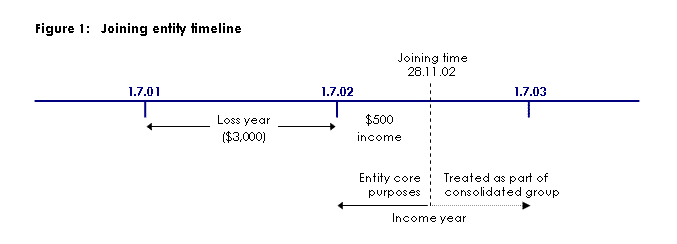Consolidation Reference Manual
You can still refer to the Consolidation reference manual for consolidation information that has not been impacted by changes in the legislation.
C3 Losses
C3-3 Worked example - loss transfer
Establishing the unutilised loss
C3-3-110 Establishing unutilised loss at transfer time - single joining time and prior year loss case
Description
This example shows how an entity establishes what losses are unutilised as at the joining time, assuming a single joining time and a tax loss in the income year prior to joining.
Commentary
An entity that joins a consolidated group transfers any unutilised losses on hand at the joining time to the head company.
Section 707-115 states that when an entity joins a consolidated group, only a loss made by the entity for an income year ending before the joining time is subject to the transfer provisions of Subdivision 707-A. Subsection 707-115(2) requires that only the unutilised amount of a loss is subject to the subdivision.
Example
Facts
An entity joins a consolidated group on 28 November 2002 with a tax loss of $3,000 on hand from the 2002 income year. The entity's assessable income for the joining year, calculated for the period 1 July 2002 to 27 November 2002, is $500 before the deduction for prior year losses.

Although the income year of the joining entity is 1 July 2002 to 30 June 2003, its core purposes are calculated in respect of the non-membership period that ended before the joining time, that is, 1 July 2002 to 27 November 2002. → Division 701
To establish the amount of the loss on hand at the joining time, the entity needs to bring to account its loss for the 2002 income year. This loss is greater than the income for the period 1 July 2002 to 27 November 2002 in the joining year. The unutilised amount of the 2002 loss is subject to the transfer testing process.
Calculation
Step 1: Identify the loss
A tax loss of $3,000 is identified at the joining time. Subsection 701-1(4) lists the sorts of losses that are subject to the subdivision. Paragraph 707-110(2)(a) states how a tax loss is 'utilised'.
Step 2: Income year
As the loss is for the income year that ends on 30 June 2002, it is a loss in respect of an income year that pre-dates the joining time of 28 November 2002.
Therefore, the joining entity's loss of $3,000 satisfies the criteria for application of the loss transfer provisions.
Step 3: Establish the unutilised amount of the loss as at the joining time
In calculating its taxable income for the 2003 income year, the joining entity is able to utilise $500 of the loss (assuming the recoupment tests are satisfied). The joining entity is required to calculate its taxable income in accordance with the core rules in Division 701.
This satisfies the requirement in Paragraph 707-115(2)(b) that only the net amount of the loss is subject to the transfer testing process, as the initial loss is utilised to the extent of $500 'in working out the joining entity's taxable income (if any) for the joining year'.
Thus, the $2,500 remaining of the joining entity's 2002 loss is subject to the transfer testing process of section 707-120.
References
Income Tax Assessment Act 1997 - as amended by New Business Tax System (Consolidation) Act (No. 1) 2002 (No. 68 of 2002), Schedule 1 :
- •
- subsection 701-1(4)
- •
- paragraph 707-110(2)(a)
- •
- section 707-115
- •
- paragraph 707-115(2)(b)
- •
- section 707-120
Explanatory Memorandum to the New Business Tax System (Consolidation) Bill (No. 1) 2002, Chapter 6
Current at 2 December 2002
